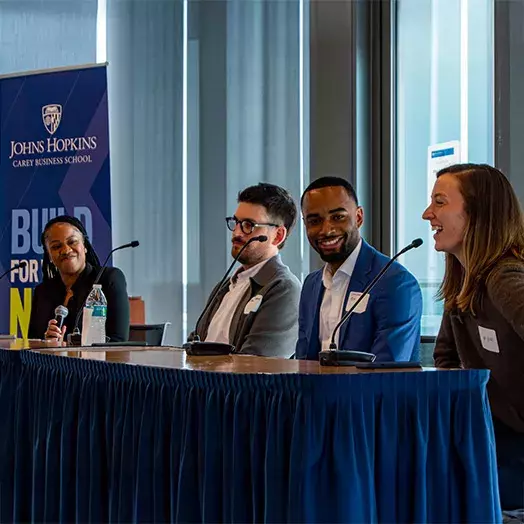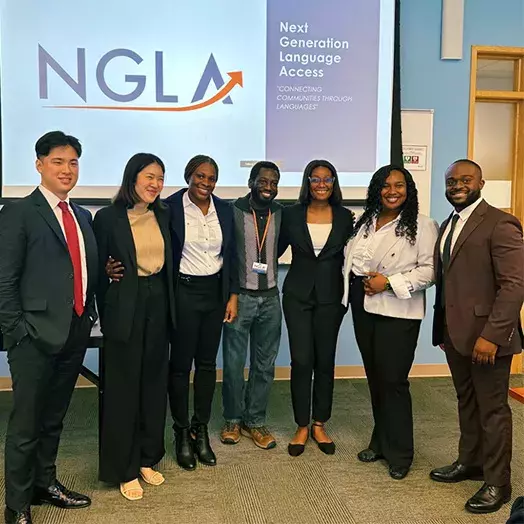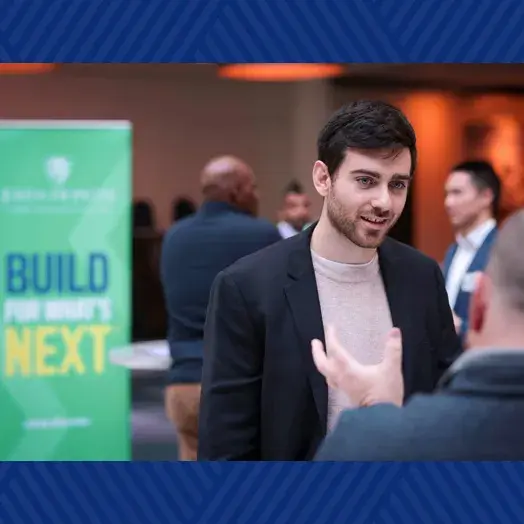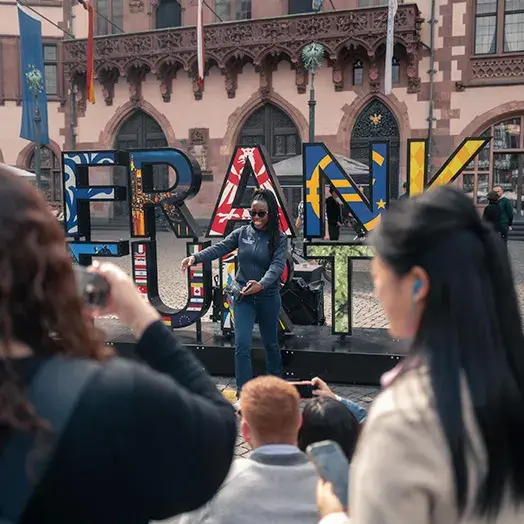MA/MBA students flex their business acumen and artistic creativity at a collaborative event they hosted to bring the power of design thinking to some sticky community situations.

Dual-degree students design the future at Carey’s inaugural Design-Thinking Conference
With just a few minutes to spare, Luis Flores, a sophomore from Columbia University, grabbed a Sharpie from the table and got to work, sketching the food delivery truck that he and the rest of his group had proposed as a way to increase access to food banks.
As he drew, others made suggestions. The side of the truck could have a list of local health resources, one person said. And let’s add picnic tables, so it’s more welcoming, said another. And how about a signature jingle, like an ice cream truck, so people know when it's in their neighborhood? Flores added the ideas as they came in, finishing the drawing just as the exercise came to an end.
Throughout the room, other groups were also tackling their assigned problems during the Johns Hopkins Carey Business School’s first-ever Design for America (DFA) Design-Thinking Conference, a day-long event held at Carey’s Harbor East home in Baltimore.
Design for America, founded at Northwestern University in 2008, exists through student-led branches at universities across the country, offering workshops, conferences, and partnerships that foster collaboration, creativity, and empathy in community-focused innovation.
What is design thinking?
“Design-centered thinking is an innovative, problem-solving approach to any organizational challenge or issue,” explained Brendan "Bren" Forester, president of the local Design for America chapter, based at Johns Hopkins University and the Maryland Institute College of Art. “It uses creative problem-solving and gets into the minds and experiences of the stakeholders.”
Forester and fellow organizer Stephanie Lawrence, vice president of the chapter, are both in the joint Design Leadership MA/MBA program at Carey and MICA, as are Charlotte Beatty, the chapter’s director of strategy, and Julia Dang, its director of engagement.
The unique collaboration between renowned Baltimore institutions allows students to earn two degrees simultaneously: a Master of Business Administration from Carey and a Master of Art in Design Leadership from MICA. The MA/MBA program highlights the role of creativity in business success, a philosophy that dovetails with DFA’s.
Participants at the DFA event got a first-hand taste of the freewheeling, collaborative, and empathetic approach that characterizes design-centered thinking with a “design sprint,” which gave each table of 8 to 10 participants one of two challenges to address: how to remove access barriers to food banks, or how to improve mental health care for young people.
“I really like that it’s a creative space,” said Ava Fung, a cognitive science major and director of membership for the DFA chapter at Columbia University. “One of the reasons I joined the club was to see the nationwide network and go to cool things like this.”
There were also workshops on using design-centered thinking for social impact or data-driven design, and a panel discussion about the emerging role of AI, led by Tracy Akinade, Carey’s associate director for community engagement and economic impact.
What to Read Next

student experience
Experiential Business Communication course wins AACSB Innovations That Inspire awardCommunity-focused innovation
About 100 people attended the inaugural event, including students from Carey, MICA, and other schools; business and government leaders, and people simply interested in using a design-centered approach to the challenges of their jobs and their communities.
“I’m interested in hearing more about what’s happening around design thinking,” said Baltimore resident Melissa Macchiavelli, an information architect who works on federal government systems. “What can I bring to my client that might be new and interesting?”
The atmosphere was lively, with upbeat music between speakers and activities. “We’re not going for perfection today,” Beatty promised as she introduced the design sprint. “It’s about experimenting and being creative.”
To start, each group had five minutes to discuss their assigned problem and to think about the people involved. Macchiavelli, in one of the food access groups, said people with disabilities might have particular challenges getting to food banks.
Lijo Panghat, in the same group, noted the prevalence of food allergies, and recalled meeting a man who could only eat soft foods because of dental issues. As members of the group talked, they jotted their notes on neon-colored sticky notes, which another participant, Ally Merrett, a Chicago-based Design for America program coordinator, arranged by theme on a poster-sized sheet of paper.
Then participants switched tables and interviewed others about their experiences with either food banks or mental health support. For one food access group, it produced an important insight: The erratic hours of volunteer-run organizations are a huge barrier for people who show up, only to find the door locked.
The exercise ended with each group describing their project. In addition to the neighborhood food truck, there was an in-school grocery store and a food delivery service on college campuses. For mental health, one group proposed a play space run by young people, and another suggested that schools build mental health activities into their days.
The winning proposal – by informal vote – proposed a game that would help children distinguish between online and offline personalities.
Designing the future
Afternoon sessions focused on the opportunities and limitations of data and AI.
“Data can inform your design,” said Katherine Fata, communications data analyst at DePaul University. “But numbers alone don’t tell the full story.”
The same idea came up in a panel discussion about AI, with consultants Michael Cameron of Deloitte and Johnathan Ashe of Guidehouse, as well as Ari Hicks, deputy director of AI for Fearless, a Baltimore-based software company with government and healthcare clients.
“Every single day you’re not reading about the newest thing, you’re behind,” said Hicks, who noted that creating effective systems requires “re-centering the human and thinking about how these problems are addressing real-life issues for real people.”


